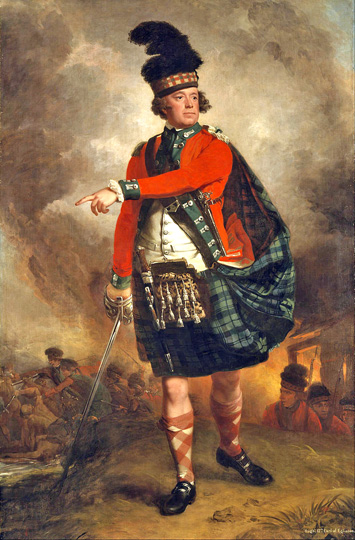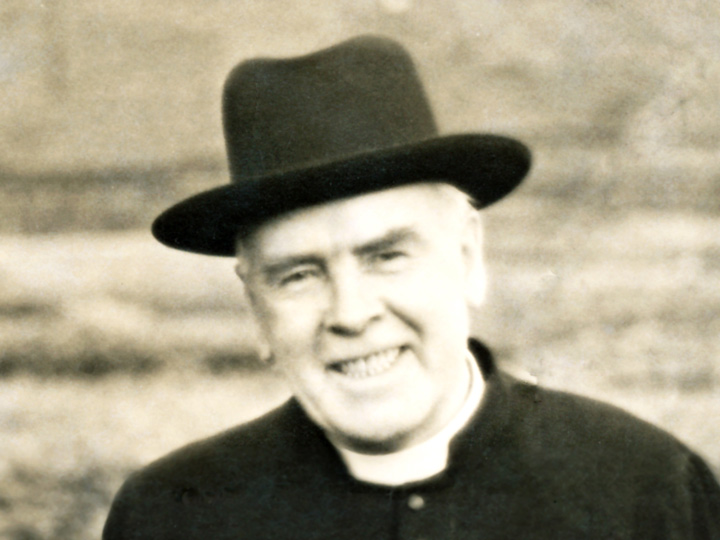 Recently, a large and pleasant ‘heroic’ portrait of
the Twelfth Earl of Eglinton came into the market and was purchased for the
Scottish National Portrait Gallery, Edinburgh.
Certain repairs having been found necessary and
completed, the portrait has been cleaned and is now exhibited in the Queen
Street gallery.
The Earl is pictured in full Highland uniform –
feather bonnet, red jacket faced with green and laced with silver, belted plaid
or ‘big kilt’ of Government or ‘Black Watch’ tartan and red and white hose.
He directs an attack with drawn broadsword and
in the background is a battle
scene with struggling Highlanders and Redskins.
Although the portrait has clearly been painted
in the 1780s showing the subject not only well on in his forties – as he then
would be – but in uniform of the fashion of that date.
The intention is obviously the commemoration of
his war service in the early 1760s.
His uniform bears the facings of his old
regiment of the American war and not the yellow ones of the Argyll or Western
Fungibles in which he was a Major from 1778 to 1783 so that an effort seems to
have been made to avoid at least one discrepancy.
As a likeness, it is interesting and convincing
to compare the portrait with the two representations of the Earl in Kay’s
Edinburgh Portraits.
Hugh Montgomerie, Twelfth Earl of Eglinton
(1739-1819) was the son of Alexander Montgomerie of Coilsfield, Ayrshire.
He entered the Army in 1756, aged 17, served in
American war of 1757 to 1763 and fought at Quebec and Saint John in the 78th
Fraser Highlanders.
Later he was with the 1st Royals.
Although this was his only war service, he
later held a majority in the Western Fencibles of 1793 to 1799.
Apart from military services, he was Member of
Parliament for Ayrshire from 1780 but resigned to become Inspector of Military
Roads in Scotland.
In 1796, he succeeded to the Earldom and became
a Representative Peer, Lord Lieutenant of Ayrshire and State Councillor to the
Prince Regent.
He was responsible for many schemes such as
improving and extending roads in the Highlands, commencing the harbour works of
Ardrossan and the construction of a canal from Glasgow to Johnstone.
He was feudal in character with a taste for
magnificence and the grand style.
Although the portrait is such an ‘important’
work, it does not appear to have been engraved and so far, as it has not been
possible to identify the artist.
It was labelled as by Raeburn when originally
at Eglinton Castle – for the rebuilding of which the Twelfth Earl was
responsible – but it is hardly possible to accept this.
The attribution to David Martin, borne recently
when in the saleroom, is also somewhat hard to accept.
A replica with minor variations is in the
County Buildings, Ayr, and a small version appears in the Scottish Service
Museum in Edinburgh Castle.
Recently, a large and pleasant ‘heroic’ portrait of
the Twelfth Earl of Eglinton came into the market and was purchased for the
Scottish National Portrait Gallery, Edinburgh.
Certain repairs having been found necessary and
completed, the portrait has been cleaned and is now exhibited in the Queen
Street gallery.
The Earl is pictured in full Highland uniform –
feather bonnet, red jacket faced with green and laced with silver, belted plaid
or ‘big kilt’ of Government or ‘Black Watch’ tartan and red and white hose.
He directs an attack with drawn broadsword and
in the background is a battle
scene with struggling Highlanders and Redskins.
Although the portrait has clearly been painted
in the 1780s showing the subject not only well on in his forties – as he then
would be – but in uniform of the fashion of that date.
The intention is obviously the commemoration of
his war service in the early 1760s.
His uniform bears the facings of his old
regiment of the American war and not the yellow ones of the Argyll or Western
Fungibles in which he was a Major from 1778 to 1783 so that an effort seems to
have been made to avoid at least one discrepancy.
As a likeness, it is interesting and convincing
to compare the portrait with the two representations of the Earl in Kay’s
Edinburgh Portraits.
Hugh Montgomerie, Twelfth Earl of Eglinton
(1739-1819) was the son of Alexander Montgomerie of Coilsfield, Ayrshire.
He entered the Army in 1756, aged 17, served in
American war of 1757 to 1763 and fought at Quebec and Saint John in the 78th
Fraser Highlanders.
Later he was with the 1st Royals.
Although this was his only war service, he
later held a majority in the Western Fencibles of 1793 to 1799.
Apart from military services, he was Member of
Parliament for Ayrshire from 1780 but resigned to become Inspector of Military
Roads in Scotland.
In 1796, he succeeded to the Earldom and became
a Representative Peer, Lord Lieutenant of Ayrshire and State Councillor to the
Prince Regent.
He was responsible for many schemes such as
improving and extending roads in the Highlands, commencing the harbour works of
Ardrossan and the construction of a canal from Glasgow to Johnstone.
He was feudal in character with a taste for
magnificence and the grand style.
Although the portrait is such an ‘important’
work, it does not appear to have been engraved and so far, as it has not been
possible to identify the artist.
It was labelled as by Raeburn when originally
at Eglinton Castle – for the rebuilding of which the Twelfth Earl was
responsible – but it is hardly possible to accept this.
The attribution to David Martin, borne recently
when in the saleroom, is also somewhat hard to accept.
A replica with minor variations is in the
County Buildings, Ayr, and a small version appears in the Scottish Service
Museum in Edinburgh Castle.The Scotsman, 1 March 1950
